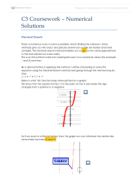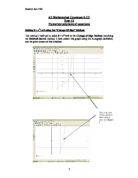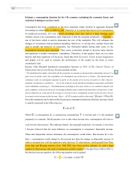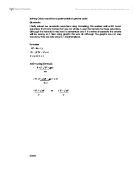C3 Coursework - different methods of solving equations.
C3 Coursework - Numerical Solutions Decimal Search There a numerous ways to solve a problem and in finding the unknown. Some methods give you the exact and precise answer but usually are harder and more complex. The Decimal search method enables you to get a very close approximate to the real solution but more easily. The way this method works is by looking between two numerical values (for example 1 and 2) and then As a demonstration in applying this method, I will be attempting to solve this equation using the Decimal Search method and going through the method step by step: Below is what this function looks when plotted on a graph: We know that the solution for F(x) = 0 is the point on the X axis where the sign changes from a positive to a negative. So if we zoom in a little bit further, from this graph we can tell where the solution lies, somewhere between 0 and 10 Now that we know the solution is roughly between these two values, I will use excel to solve the problem with firstly taking increments in x, the size of 1. So when I substitute the incremented values of x between -10 and 0 into the equation, I get the following results: x F(x) -1 20 -2 9 -3 0 -4 -13 -5 -56 -6 -125 -7 -226 -8 -365 -9 -548 You can tell that the sign changed between -3 and -4. So I set these as my initial values. The fact that the solution lies between -3 and -4 can
The Gradient Function
The Gradient Function Aim: To find the gradient function of curves of the form y=axn. To begin with, I should investigate how the gradient changes, in relation to the value of x. Following this, I plan to expand my investigation to see how the gradient changes, and as a result how a changes in relation to this. Method: At the very start of the investigation, I shall investigate the gradient at the values of y=xn. To start with, I shall put the results in a table, but later on, as I attempt to find the gradient through advanced methods, a table may be unnecessary. As I plot the values of y=x2, this should allow me to plot a line of best fit and analyze, and otherwise evaluate, the relationship between the gradient and x in this equation. I have begun with n=2. After analyzing this, I shall carry on using a constant value of "a" until further on in the investigation, and keep on increasing n by 1 each time. I shall plot on the graphs the relative x values and determine a gradient between n and the gradients. Perhaps further on in the investigation, I shall modify the value of a, and perhaps make n a fractional or negative power. Method to find the gradient: These methods would perhaps be better if I demonstrated them using an example, so I will illustrate this using y=x2. This is the graph of y=x2. I will find out the gradient of this curve, by using the three methods -
Numerical solutions of equations
A2 Mathematics Coursework C3 Year 12 Numerical solutions of equations Solving 0 = x5+x-5 using the "Change Of Sign" Method The method I will use to solve 0 = x5+x-5 is the Change of Sign Method involving the Decimal Search method. I have drawn this graph using the Autograph Software, and the print screen of this is below: From my graph above, I can see that the root of this equation is between x =1 and x = 1.5. The table of x values and f(x) values is shown below. I can work out the f(x) values by substituting the x-values into the equation. x .1 .2 .3 .4 .5 f(x) -3 -2.28949 -1.31168 0.01293 .77824 4.09375 From my table of values above, it is clear that the change of sign from negative to positive occurs between x = 1.2 and x = 1.3. So, I can narrow these values down further to find another change of sign. x f(x) .21 -1.19626 .22 -1.07729 .23 -0.95469 .24 -0.82837 .25 -0.69824 .26 -0.56420 .27 -0.42616 .28 -0.28403 .29 -0.13769 .30 0.01293 I can see that the change of sign is between x = 1.29 and x = 1.30. x f(x) .291 -0.12283 .292 -0.10792 .293 -0.09296 .294 -0.07797 .295 -0.06293 .296 -0.04784 .297 -0.03271 .298 -0.01754 .299 -0.00233 .300 0.01293 The change of sign is in the interval [1.299, 1.300] x f(x) .2991 -0.000805 .2992 0.000720 .2993 0.002244 The root of this equation lies in the interval
Estimate a consumption function for the UK economy explaining the economic theory and statistical techniques you have used.
Estimate a consumption function for the UK economy explaining the economic theory and statistical techniques you have used. Consumption has been considered as the most important single element in aggregate demand, accounting for almost 66% of GDP in 1989. Therefore, it is essential that the level of consumption be predicted accurately, for even a small percentage error may lead to a large absolute error. Another reason why consumption such important is that the marginal propensity of consume is one of the factor which is used to determine the size of the multiplier. This will influence the changes of investment and government spending. Moreover, as saving ratio, another factor that used to predict the behavior of consumers, has fluctuated rapidly during these years, so the consumption become more important. Thus, many economists attempt to develop many theories and equations to predict consumers' expenditure. Therefore, in this project, there are two main theories and their equations will be given. Some data from Economic Trends Annual Supplement and graphs will be used to estimate the performance of the model on the basis of some econometric tests. Keynes, John Maynard introduced consumption function in 1936. In The General Theory of Employment Interest and Money, Keynes pointed out that " We should therefore define what shall call the propensity to consume as the
C3 Mei - Numerical Methods to solve equations
C3 Coursework In this coursework, I will use numerical methods to solve the following equation, as I cannot solve it algebraically. I can only obtain an approximation of the solution as it is impossible or hard to find the exact value of the function. Decimal Search The graph below is the function I will use decimal search in order to find an approximation of one of the roots. The table below shows decimal search. Each boundary is tested for sign change which indicates that a root exists between them. The x where the sign change occurs in now the new boundaries and tested for sign change again. This method is repeated until an approximation of the root is found to a suitable number of decimal places. x f(x) 0 2 0.1 .9501 0.2 .8016 0.3 .5581 0.4 .2256 0.5 0.8125 0.6 0.3296 0.7 -0.2099 0.8 -0.7904 0.9 -1.3939 -2 x f(x) 0.66 0.011747 0.661 0.006295 0.662 0.000838 0.663 -0.00462 0.664 -0.01009 0.665 -0.01556 0.666 -0.02104 0.667 -0.02652 0.668 -0.032 0.669 -0.03749 0.67 -0.04299 x f(x) 0.662 0.000838 0.6621 0.000292 0.6622 -0.00025 0.6623 -0.0008 0.6624 -0.00135 0.6625 -0.00189 0.6626 -0.00244 0.6627 -0.00299 0.6628 -0.00353 0.6629 -0.00408 0.663 -0.00462 x f(x) 0.6 0.3296 0.61 0.277958 0.62 0.225763 0.63 0.17303 0.64 0.119772 0.65 0.066006 0.66 0.011747 0.67 -0.04299 0.68 -0.09819
Solving Cubic equations or polynomials of greater order
Solving Cubic equations or polynomials of greater order Quadratic I firstly solved our quadratic equations using factorising, this worked well until I found equations that have factors that are not whole. I used the formula for these equations, although the formula is very hard to remember and if it's written incorrectly the answer will be wrong, so I tried using graphs this was ok although the graphs are not very accurate, they are only around 1 decimal place. Factorise X² - 6x + 5 (x - 5) (x - 1) = 0 x = 5 or x = 1 Solve using formula - b +/- V b² - 4ac 2a + 6 +/- V 36 - 4 x 1 x -5 2 x 1 + 6 + V 56 or + 6 - V 56 2 2 Cubic Here I first tried solving the equations by factorising, as with the quadratic equations this worked well until I came across equations with factors including decimal places. For these I tried as before to use the formula but I firstly need to find one of the factors, and if all factors include decimal places this can be difficult. So I lastly tried to solve the equation using graphs, this was extremely hard as the cubic graph needs more detail and I found that the graph as before was only correct to one decimal place. This is not accurate enough for a cubic graph. Now, I have decided to go and look for other ways in which it would be possible to find all the factors of the equations which is accurate. I have now found a new
Design, make and test a Sundial.
Sundial Coursework Statement of Task: To design, make and test a Sundial. Introduction: The sundial is the oldest know device for measuring time. The first confirmed uses of it where by the Babylonians in around 2000BC. However it is safe to say that shadows have been used as a rough measure of time ever since primitive man discovered that as the day progresses the shadows of trees and rocks get shorter and then longer again. The sundials used by the Babylonians were hollow half spheres, set with edges flat and with a small bead at the centre. As the day wore on the shadow of the bead followed a circular arc, which is divided into 12 "temporary hours" (they changed through the seasons). A modern sundial consists of a plane (dial face) and the gnomon (style). The dial face is divided into hours and the gnomon is the flat piece of metal, or stick in the dials centre, it points towards the North Pole (in the northern hemisphere) or South Pole (in the southern hemisphere). The gnomon must tilt at the angle of the latitude at the location. Although a sundial seems like a simple device for measuring time, it is not. One cannot simply look at the shadow and find the time. Firstly the sundial will show local time, not GMT. Secondly we must allow for the 'equation of time.' Because the Earth's orbit is not circular, its velocity changes at the perihelion. To allow for this
Numerical solution of equations
Pure Mathematic 2 Coursework Numerical solution of equations By Michael Pang I am going to show 3 of the numerical methods for solving the equation which cannot be solved algebraically. They are interval estimation, fixed point estimation and Newton-Raphson method. Those of these numerical methods are used when algebraic ones are not available. When you found any equations which cannot be solved algebraically, probably you will draw the graph and see where the roots are. However, the other problem is found that you cannot get all roots accuracy. Actually, the numerical methods cannot find the exactly root but the answers are more accuracy than sketching the graphs. Therefore, we usually provide the answer to 5 or 6 decimal places depending on what the questioner needs. Finally, we check the answer by setting the lower bound and upper bound to see whether it has sign change or not. Even if the three numerical can solve the equation non-algebraically, they have its advantages and disadvantages. And now I am going to show how these methods works and their problems by using the equation F(x) = x³-9x+3. Interval estimation Assume that the roots of the equation F(x) = x³-9x+3, and I am looking for the roots which F(x) = 0. The roots of the equation are the values of x which the graph of y = x³-9x+3 crosses the x axis. By using the computer, I recognise that there are 3
Mathematics portfolio - Translations.
Man Ju Y12D Mathematics - portfolio Translations . 2. is the effect of translation vector of . It moves up 2 units. is the effect of translation vector of . It moves up 4 units. is the effect of translation vector of . It moves down 3 units. 3. + 3 is the effect of translation vector of . It moves up 3 units. -1 is the effect of translation vector of . It moves down 1 unit. 4. Curves move either up or down vertically. The units they move is according to the number after x2 in the equation . If the number is positive, the curve will be pulled upwards. If the number is negative, the curve will be pulled downwards. 5. f(x) = sinx -2 is the effect of translation vector of f(x) = sinx. It moves down 2 units. This has the same effect with the previous examples. The unit it moves is according to the number after sinx in the equation f(x) = sinx c. If the number is positive, the curve will be pulled upwards. If the number is negative, the curve will be pulled downwards. Therefore the generalization extends to any function f(x). 6. 7. is the effect of translation vector of . It moves right 2 units. is the effect of translation vector of . It moves right 3 units. is the effect of translation vector of . It moves left 1 unit. is the
OCR MEI C3 Coursework - Numerical Methods
C3 Coursework Change of sign (decimal search) Finding a root of an equation with graphical illustration f(x)=x3-7x2+2x+1 This is graph of y=x3-7x2+2x+1 The graph shows that roots of f(x)=0 exist in the intervals [-1,0]; [0,1]; [6,7] We shall test for a root in the interval [6,7] x f(x) 6.0 -23 6.1 -20.289 6.2 -17.352 6.3 -14.183 6.4 -10.776 6.5 -7.125 6.6 -3.224 6.7 0.933 Change of sign indicates root exists in interval [6.6,6.7] This means that x=6.65±0.05 x=7 (0d.p.) x f(x) 6.60 -3.224 6.61 -2.81992 6.62 -2.41327 6.63 -2.00405 6.64 -1.59226 6.65 -1.17787 6.66 -0.7609 6.67 -0.34134 6.68 0.080832 Change of sign indicates root in interval [6.67,6.68] This means that x=6.675±0.005 x=6.7 (1d.p.) x f(x) 6.670 -0.34134 6.671 -0.29924 6.672 -0.25711 6.673 -0.21496 6.674 -0.17278 6.675 -0.13058 6.676 -0.08835 6.677 -0.04609 6.678 -0.00381 6.679 0.038498 Change of sign indicates root in interval [6.678,6.679] This means that x=6.6785±0.0005 x=6.68 (2d.p.) X f(x) 6.6780 -0.00381 6.6781 0.000419 Change of sign indicates root in interval [6.6780,6.6781] This means that x=6.67805±0.00005 x = 6.678 (3d.p.) Failure of the decimal search Two of the roots of f(x)=0 where f(x)=5x3-20x2+2x-0.05 could not be found with this method. This is because they are so close together that there is no sign change













